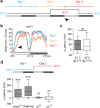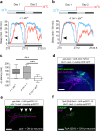Regulation of sleep plasticity by a thermo-sensitive circuit in Drosophila
- PMID: 28084307
- PMCID: PMC5233985
- DOI: 10.1038/srep40304
Regulation of sleep plasticity by a thermo-sensitive circuit in Drosophila
Abstract
Sleep is a highly conserved and essential behaviour in many species, including the fruit fly Drosophila melanogaster. In the wild, sensory signalling encoding environmental information must be integrated with sleep drive to ensure that sleep is not initiated during detrimental conditions. However, the molecular and circuit mechanisms by which sleep timing is modulated by the environment are unclear. Here we introduce a novel behavioural paradigm to study this issue. We show that in male fruit flies, onset of the daytime siesta is delayed by ambient temperatures above 29 °C. We term this effect Prolonged Morning Wakefulness (PMW). We show that signalling through the TrpA1 thermo-sensor is required for PMW, and that TrpA1 specifically impacts siesta onset, but not night sleep onset, in response to elevated temperatures. We identify two critical TrpA1-expressing circuits and show that both contact DN1p clock neurons, the output of which is also required for PMW. Finally, we identify the circadian blue-light photoreceptor CRYPTOCHROME as a molecular regulator of PMW, and propose a model in which the Drosophila nervous system integrates information encoding temperature, light, and time to dynamically control when sleep is initiated. Our results provide a platform to investigate how environmental inputs co-ordinately regulate sleep plasticity.
Figures






References
-
- Borbély A. A. A two process model of sleep regulation. Hum Neurobiol 1, 195–204 (1982). - PubMed
Publication types
MeSH terms
Substances
Grants and funding
LinkOut - more resources
Full Text Sources
Other Literature Sources
Molecular Biology Databases

